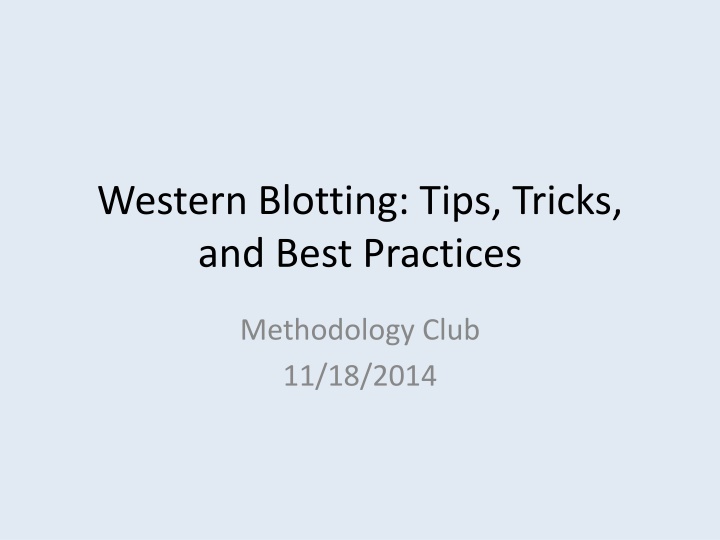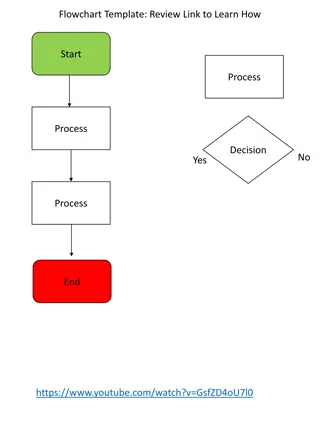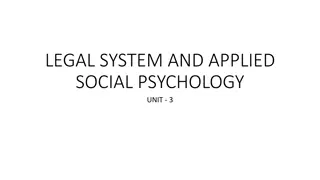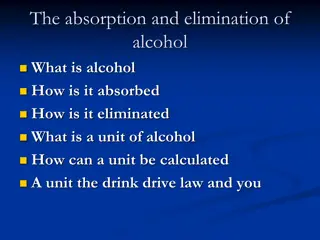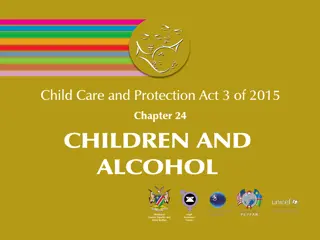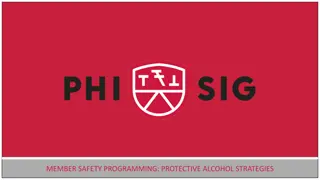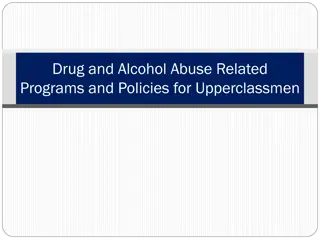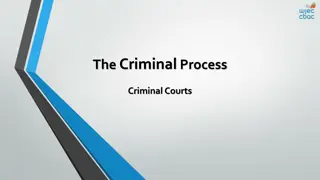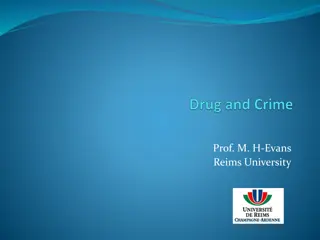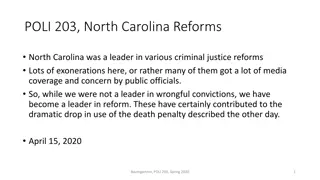Alcohol Screening & Brief Interventions in Criminal Justice Settings
The use of motivational interviewing and alcohol brief interventions to reduce alcohol consumption in hazardous drinkers within Community Criminal Justice Settings in the UK. Learn about prevalence rates, effectiveness of interventions, and proposed mapping exercise to identify opportunities for interventions in CJS.
Download Presentation

Please find below an Image/Link to download the presentation.
The content on the website is provided AS IS for your information and personal use only. It may not be sold, licensed, or shared on other websites without obtaining consent from the author.If you encounter any issues during the download, it is possible that the publisher has removed the file from their server.
You are allowed to download the files provided on this website for personal or commercial use, subject to the condition that they are used lawfully. All files are the property of their respective owners.
The content on the website is provided AS IS for your information and personal use only. It may not be sold, licensed, or shared on other websites without obtaining consent from the author.
E N D
Presentation Transcript
Western Blotting: Tips, Tricks, and Best Practices Methodology Club 11/18/2014
Western Blotting Run Gel Transfer to Membrane Probe with antibody(s) Develop to obtain signal Quantify signal
PAGE Gels Sealing bottom of glass plates to prevent leaks 0.5% Agarose + 0.5% SDS High APS/TEMED Acrylamide solution Ice + High voltage (300V+) for faster runs Gunk in wells Lower APS/TEMED amount Make sure combs are not bent/curved
PAGE Gels Tris-glycine classic system Tris-Acetate [1] pH 7, better separation range Tris-Tricine [2,6] pH 7 More efficient stacking/destacking, higher resolution at some MWs Also, longer shelf-life, because no pH-dependant degradation of acrylamide Agarose [3,4] Large MW proteins Riboflavin-phospate + UV light can be used instead of APS/TEMED [5,6] Allows for lengthy setup, such as with multi-casting or gradient gels Better for N-terminal sequencing
Choice of Membrane Nitrocellulose PVDF Available Pore Sizes 0.1, 0.2, 0.45 0.2, 0.45 80-250 ug/cm2 150-350 ug/cm2 Binding Capacity Durability Fragile when dry Sturdy Background Generally low Generally high Chemical properties Binds irreversibly to coomassie Can be dissolved Can be destained from coomassie Tighter protein binding Compatibility w/ N-terminal sequencing (Edmond) Incompatible Compatible Interaction with SDS SDS inhibits binding of proteins Less protein binding inhibition by SDS
Electro-transfer to Membranes Tank Slow Uses a lot of buffer More quantitative transfer More versatile Semi-dry Fast Lower materials cost Not-quantitative http://www.western- blot.us/uploads/images/Western- Blot-Transfer.jpg
Tank Transfer High intensity 100-200V for 0.5-2 Hrs. Low intensity 30V for 16 Hrs. Biphasic [7] Low voltage, followed by high voltage Square wave [7] 2 steps forward, one step back
Tank Transfer - Buffers Towbins [8] Tris/Glycine based with Methanol Bjerrum Schafer-Nielsen [9] Tris/Gly w/low glycine + MeOH For semi-dry or Tank transfer of >80kDa proteins CAPS or Dunn Carbonate High pH (9-11) buffers, no tris/gly Acetic Acid (0.7%) Transfer of positively charged proteins in the reverse direction
Tank Transfer Methanol vs. SDS Methanol aids in protein binding to membranes, especially nitrocellulose SDS inhibits protein binding, especially with nitrocellulose Methanol strips SDS from proteins making it harder for them to exit the gel SDS aids in getting proteins out of the gel Test between 0-20% MeOH and 0-0.1% SDS
Tank Transfer Native Transfer pH extremely important No SDS to impart negative charge High pH buffer, such as CAPS, to ensure protein has negative charge Alternatively, you can stay below the pI and transfer in reverse (towards the cathode, as the protein will be positively charged) Gel/Membrane contact Air/buffer will cause artifacts Test tube as roller Glass-rod Filter paper stuck to gel/membrane Add water Dry membranes after transfer helps fix proteins to membrane [10]
Blocking Tween-20 [11,12] 0.25-2% May wash off a small amount of protein from blot May cause background with some forms of imaging Non-fat dry milk Super cheap ~5% Has endogenous biotinylated proteins IgGs that can cross-react with anti-goat antibodies Goes sour BSA 1-5% No blocking [13] Dried PVDF only Fish Gelatin Expensive
Tween-20 for Blocking BSA Time Time Tween 5-10 min exposure
Probing with Antibodies Lowest dilution that gives good signal Can probe for as little as 30 min Microwave assisted incubations for quicker probe times [14] Membranes can be stripped and re-probed multiple times [15, 16] PVDF better for this Can lose some of protein bound to blot Heat + SDS, Low-pH, or High-pH SDS in antibody stocks (0.01-0.05%) Can decrease background Can actually increase signal by revealing epitopes Especially when using protein based blocker
Secondary Antibody Conjugates Alkaline Phosphatase Colorimetric (NBT/BCIP) Fluorescent (ECF) Horseradish Peroxidase Colorimetric (CN/DAB) Flourescent (ECL Plus) Light based via Film or CCD camera (ECL, ECL Plus, etc) Fluorescent Dyes Alexa flour dyes for imaging on Typhoon scanner More dynamic range than Film, but sacrifices some sensitivity Multiplex possible [17] Gold [7] Usually silver-enhanced detection
Exposing Blots to Film (HRP) Page Protectors Works better than saran wrap for storing blots, don t have to worry about wrinkles Make sure no air bubbles, but also don t too forceful such that there is little developing solution on blot Fuzzy bands Possible that film was not flat on blot The greater the distance between film and blot, the more time for light to diffract and thus broaden the band White in the middle of a band If you have too much signal, the substrate can be used up, paradoxically reducing your signal Signal is usually highest in center of a band, thus this is the area where substrate will be depleted first
Quantification ImageJ [18] Free from NIH ImageQuant Available on Typhoon computers ($oftware) Other free programs LiCor Image Studio [19] Like a hybrid of ImageJ and ImageQuant Others?
Quantification - Pitfalls Non-linearity Film only has a dynamic range of ~1.8 orders of magnitude (65x) Saturated signal does not give accurate quantification Binding capacity of membrane Inter-blot comparisons All quantification needs to be intra-blot unless an identical sample is loaded between blots to normalized Linearity of Sample 12 9 Band Intensity 6 3 0 0 5 10 15 20 25 30 Sample Amt
Quantification - Pitfalls All values are relative without a standard quantified by some other means Compare to how you do a protein assay (bradford/ lowry) Protein levels can vary with respect to each other, but claims such as twice as much protein A as protein B cannot be made without a standard Substrate can be limiting for enzyme coupled 2 antibodies White in the middle of HRB band = depleted substrate
Quantification Bands need to be of appropriate intensity (not saturated) and separated Stacking can cause bands to spread in the horizontally Likely caused by salts pH 8.8 + glycerol stacking gel Addition of salt to equalize between samples
Staining of Membranes Ponceau [20] Quick, reversible stain (red) Limited detection Coomassie [20] Works poorly for Nitrocellulose (almost irreversible binding India ink [20] Irreversible, easy stain, black bands May or may not effect antigenicity Can t stain post-western if protein-based blockers used Another pro for Tween-20 blocking
Tools Tien Lab Gradient gel casting equipment Multi-gel caster (12x) [Biorad #165-4110] Combs for 2nd dimension SDS-PAGE Dark room 4th Floor S. Frear 2x in Althouse Typhoon Scanners 4th Floor S. Frear 206 Althouse (better one; more lasers)
Primary Antibody Development Peptide Design unique 20-30-mer peptide Affinity purification by coupling to gel in column format Highly flexible, but $$$$ Protein Heterologous express all or part of target protein Or purify from source Purification By coupling to gel in column format Transfer protein to membrane, bind antibodies, elute from membrane [21] Background removal Cross-purify with similar proteins Incubate antibody with strip of membrane containing protein from knockout line
Crazy Other Stuff Alternative membranes [7] Teflon GORE-TEX Compatible with other chemistries (C-terminal sequencing) Odd membranes [7] Coomassie gel overhead transparency Activated glass for microsequencing Soaking gels in PEG enhances transfer efficiency [7]
Crazy Other Stuff MALDI-TOF mass spec directly from a membrane [7] in silico western blot Antibodies to carbohydrates [22,23] Making membranes translucent for densitrometry [7] Nitrocellulose 3in1 oil Tween-80 PVDF Ethylene glycol/glycerol
My Protocol Transfer 2 Hr @ 100V for Dry Membrane Block 20-30 min in Tween-20 1 Antibody for 30 Min A single 10 min wash 2 Antibody for 30 min 3x 5min washes Develop w/HRP + Film Digitize and then quantify with ImageJ
References [1] Cubillos-Rojas, M., Amair-Pinedo, F., Tato, I., Bartrons, R., Ventura, F., & Rosa, J. L. (2010). Simultaneous electrophoretic analysis of proteins of very high and low molecular mass using Tris-acetate polyacrylamide gels. Electrophoresis, 31(8), 1318 21. [2] Sch gger, H. (2006). Tricine-SDS-PAGE. Nature Protocols, 1(1), 16 22. doi:10.1038/nprot.2006.4 [3] Wu, M., & Kusukawa, N. (1998). SDS agarose gels for analysis of proteins. BioTechniques, 24(4), 676 8. [4] Greaser, M. L., & Warren, C. M. (2009). Efficient electroblotting of very large proteins using a vertical agarose electrophoresis system. In B. T. Kurien & R. H. Scofield (Eds.), Protein Blotting and Detection (Vol. 536, pp. 221 227). Totowa, NJ: Humana Press. doi:10.1007/978-1-59745-542-8 [5] Rabilloud, T., Vincon, M., & Garin, J. (1995). Micropreparative one- and two- dimensional electrophoresis: improvement with new photopolymerization systems. Electrophoresis, 16(8), 1414 22. [6] Rabilloud, T. (2010). Variations on a theme: changes to electrophoretic separations that can make a difference. Journal of Proteomics, 73(8), 1562 72. doi:10.1016/j.jprot.2010.04.001 [7] Kurien, B. T., & Scofield, R. H. (2009). A brief review of other notable protein blotting methods. Methods in Molecular Biology (Clifton, N.J.), 536(1), 367 84.
References [8] Towbin, H., Staehelin, T., & Gordon, J. (1979). Electrophoretic transfer of proteins from polyacrylamide gels to nitrocellulose sheets: procedure and some applications. Proceedings of the National Academy of Sciences of the United States of America, 76(9), 4350 4. [9] Bjerrum, O. J., & Schafer-Nielsen, C. (1986). Buffer systems and transfer parameters for semi-dry electroblotting with horizontal apparatus. Dunn Electrophoresis, 315 327. [10] http://www.lifetechnologies.com/us/en/home/references/protocols/proteins- expression-isolation-and-analysis/western-blot-protocol/western-blotting-using- nitrocellulose-membranes.html [11] Batteiger, B., Newhall, W. J., & Jones, R. B. (1982). The use of Tween 20 as a blocking agent in the immunological detection of proteins transferred to nitrocellulose membranes. Journal of Immunological Methods, 55(3), 297 307 [12] http://www.agrisera.com/en/info/western-blot.html [13] Mansfield, M. A. (1995). Rapid immunodetection on polyvinylidene fluoride membrane blots without blocking. Analytical Biochemistry, 229(1), 140 3. [14] Li, W., Murai, Y., Okada, E., Matsui, K., Hayashi, S., Horie, M., & Takano, Y. (2002). Modified and simplified western blotting protocol: use of intermittent microwave irradiation (IMWI) and 5% skim milk to improve binding specificity. Pathology International, 52(3), 234 8.
References [15] http://www.abcam.com/index.html?pageconfig=resource&rid=11353 [16] Yeung, Y., & Stanley, E. R. (2009). A solution for stripping antibodies from polyvinylidene fluoride immunoblots for multiple reprobing. Analytical Biochemistry, 389(1), 89 91. doi:10.1016/j.ab.2009.03.017 [17] Gingrich, J. C., Davis, D. R., & Nguyen, Q. (2000). Multiplex detection and quantitation of proteins on western blots using fluorescent probes. BioTechniques, 29(3), 636 42. [18] http://imagej.nih.gov/ij/ [19] http://www.licor.com/bio/products/software/image_studio_lite [20] Dunn, M. J. (1998). Detection of Total Proteins on Western Blots of 2-D Polyacrylamide Gels. In 2-D Proteome Analysis Protocols (Vol. 112, pp. 319 329). New Jersey: Humana Press. doi:10.1385/1592595847 [21] Kurien, B. T. (2009). Affinity Purification of Autoantibodies from an Antigen Strip Excised from a Nitrocellulose Protein Blot. In B. T. Kurien & R. H. Scofield (Eds.), Protein Blotting and Detection (Vol. 536, pp. 201 211). Totowa, NJ: Humana Press. doi:10.1007/978-1-59745-542-8 [22] Heimburg-Molinaro, J., & Rittenhouse-Olson, K. (2009). Development and characterization of antibodies to carbohydrate antigens. Methods in Molecular Biology, 534, 341 57. doi:10.1007/978-1-59745-022-5_24 [23] http://www.ccrc.uga.edu/~mao/wallmab/Antibodies/antib.htm
Western Transfer Buffer Recipes (Tank) Towbin s 25 mM Tris-HCl pH 8.3, 192 mM glycine, 20% (v:v) methanol Should not need to pH yourself Bjerrum Schafer-Nielsen 48 mM Tris, 39 mM glycine, 20% methanol Should not need to pH yourself CAPS 10 mM CAPS pH 10.5, 10% (v:v) methanol Should not need to pH yourself Dunn Carbonate 10 mM NaHCO3, 3mM Na2CO3, pH 9.9, 20% methanol Acetic Acid 0.7% Acetic Acid
Film vs. Fluorescence Dynamic Range Westen blotting principles and methods
